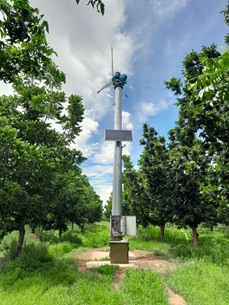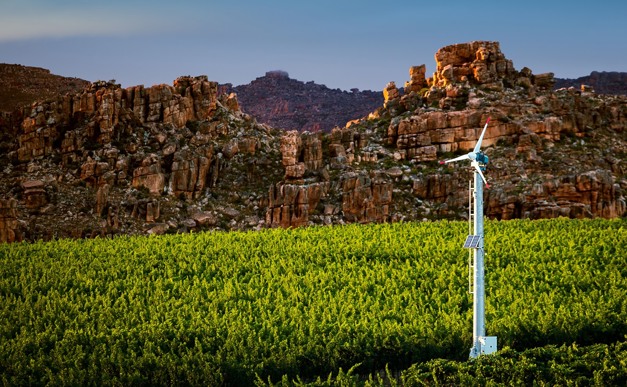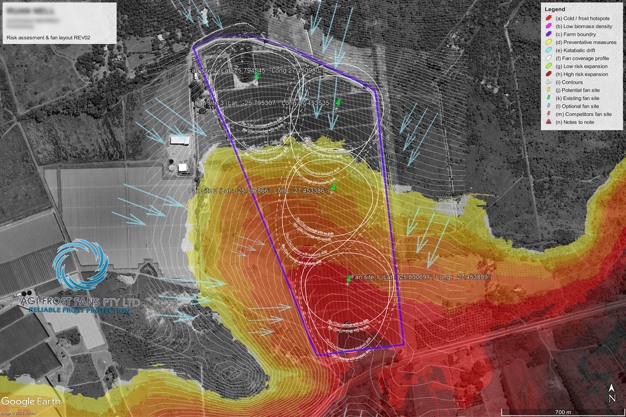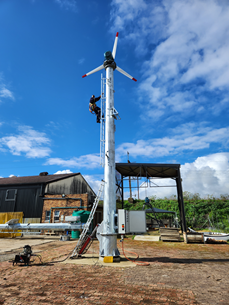 "A pretty rough frost moved through the Hex River Valley at the end of August, from De Doorns, Robertson, Bonnievale, leaving a significant amount of damaged grape vineyards," says Stiaan Hugo, general manager of AGI Frost Fans. "In Rawsonville where I grew up, we never saw frost. Now over the past five years, farmers experience a tremendous increase in the frequency of frost events."
"A pretty rough frost moved through the Hex River Valley at the end of August, from De Doorns, Robertson, Bonnievale, leaving a significant amount of damaged grape vineyards," says Stiaan Hugo, general manager of AGI Frost Fans. "In Rawsonville where I grew up, we never saw frost. Now over the past five years, farmers experience a tremendous increase in the frequency of frost events."
He remarks that in the Northern Cape farmers used to refer to a ten year frost and now frost has become an annual occurrence. The critical spring frost period is right now, and 120 AGI frost fans are whirring on fruit and wine farms across South Africa. During the bad frost of July, a Marble Hall blueberry grower could take off their crop thanks to their AGI Frost Fans.
Ten years ago Hugo and a diverse team started experimenting with fans that can push down the warm inversion layer into the heavier cold air, while stimulating a microclimate through wind movement. By 2018 AGI Frost Fans started selling the 10.5m high structures to fruit and wine farmers; two years later international clients in Chile were also buying the frost fans manufactured in Wellington, Western Cape.
They are on the cusp of selling their frost fans to US clients, met at the World Ag Expo which they attend every year.

New Zealand Zero fossil fuel pioneer is a client
AGI Frost Fans follows a risk assessment model that considers the topography, as well as biomass data through satellite imagery and cold flow analyses.
"We study the areas to determine exactly where the fan needs to be situated on a farm, instead of just placing according to a grid, finding that, perhaps, one fan suffices instead of two."

Frost risk assessment of a farm
The majority of South African users drive their AGI frost fans from the grid or with diesel generators. One AGI customer, Forest Lodge Orchard in the south of New Zealand, burns zero fossil fuels and uses a combination of solar, battery and grid power to drive their fans.
Around Augrabies in the Northern Cape a grape and citrus-growing company runs their frost fans off their 1125kW solar farm with a battery capacity of 1062kW. He observes that worldwide, 50 to 200 hours of fan use is the norm but in the Northern Cape, along the banks of the Orange River where entire citrus orchards sometimes freeze during mid-winter, their clients keep the blades turning as much as 600 hours per year.
"Citrus growers need a broad spectrum of frost protection, not only during winter to protect the tree but also to protect the blossoms in springtime and then the last of the crop to be harvested."
Most silent frost fan in the world The 30kW model is their flagship frost fan; its reach extends to 9 hectares and runs at 800 revolutions per minute, which means that noise can be a factor.
The 30kW model is their flagship frost fan; its reach extends to 9 hectares and runs at 800 revolutions per minute, which means that noise can be a factor.
For that reason, AGI Frost Fans developed the most silent frost fan in the world, measuring 42dB at 300 metres which, compared to 58dB at 300 metres, is an exponential difference. It runs at half the speed with smaller fans and offers frost protection up to an 8 hectares' remove.
Hugo observes that many farmers still only look at temperature in isolation, while relative humidity determines the severity of the frost or cold damage.
"Wet bulb temperature is a much better indication of the risk of frost risk. The more moisture in the air, the slower temperature drops," he says. Spraying water overhead while using the fans would have the opposite effect, causing evaporative cooling.
AGI expands into consulting
He's a big fan (pardon the pun) of Hortec 's weather stations and its frost forecast model. High on his R&D list is integrating weather prediction data for fans to autonomously turn on or off, with an electricity saving. AGI developed the control and monitoring interface (AGI Live) through which the frost fans currently receive instructions.
"To what degree can a crop be protected? That is very relative, depending on the phenological stage, the relative humidity, the crop itself. At -6°C you'll struggle to provide sufficient protection," he explains.
If a farm decides against installing a frost fan, the company can analyse their orchards and advise them on the many other practices to avoid cold damage: digging trenches leading heavy bodies of cold air elsewhere, keeping the orchard floor bare during the critical springtime period to allow the soil to bake during the day while there is no vegetation trapping cold air, only irrigating at certain times to maintain soil heat. He says there are many cultivation practices to reduce cold air assembling in low points.

Burning tyres: a horrible practice
"You'd be surprised how many farmers still burn tyres as a means of combatting frost." He maintains that it is still common practice on farms with crops at risk of springtime cold damage to put a match to a heap of old tyres and wood to create a smoke screen above the crop, either to trap heat or to provide additional warmth.
.
"It is such a dangerous practice, polluting the air, leaving residues on the fruit and the worst of it is that you're not only affecting yourself, you're affecting your neighbour and your neighbour's neighbour."
Hugo calls it a horrible practice with barely any efficacy and in contravention of the South African Air Pollution Control bylaw of 2021. "In other countries like New Zealand farmers are getting huge fines for burning tyres. We'd like to create some awareness around it: it's a big problem and is inefficient, there's no use in burning tyres to prevent cold damage."
 For more information:
For more information:
Stiaan Hugo
AGI Frost Fans
Tel: +27 21 873 0590
Email: info@agifrostfans.com
https://agifrostfans.com/
